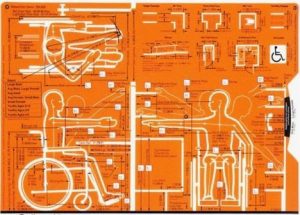February 23, 2019
Reading Time: 2 minutes Accessibility Minded
Accessibility MindedIn 1990, Congress enacted the Americans with Disabilities Act (ADA). The intention of the Act is to “provide a clear and comprehensive national mandate for the elimination of discrimination against individuals with disabilities.” When it comes to incorporating that into architecture, the use of your building is what will dictate the requirements you have to adhere to.
Public buildings: Buildings that are generally open to the public (restaurants, shopping centers, offices, schools, etc.). All spaces, entrances and exits will need to be fully accessible, as well as the route through the building (hallways, corridors, elevators) and any restrooms.
Multi-family Residential: Buildings that are for housing multiple families (apartment complexes, condominiums). If the building is elevator serviced, then all apartments will need to be handicap adaptable – which means that it can be made fully handicap accessible with minimal expense and effort. If the building is not elevator serviced, then only the apartments on the ground floor will need to be adaptable.
Private Residential: Private residences are typically excluded from being required to comply with the ADA requirements. However, some people choose to include accessibility into their design, whether it be they need it now for a disabled family member or they foresee the need in the future, like caring for aging parents.
Hotels/Motels: Buildings that are for transient or temporary occupancy, like hotels, are required to be handicap accessible in all of their public use areas, such as the entrances and exits, lobby, pools, restaurants, etc. However, only a portion of the sleeping rooms need to be ADA compliant, which is based on a specific ratio formula found in the building code.
These are just a few of the most common building types in which handicap accessibility will play a role – the key is to identify the need early on in the design process so that it can become part of a cohesive, well-functioning building that not only will be inclusive but will meet all your other needs as well.
By Stacey Ruhle Kliesch, AIA, AIA NJ Advocacy Consultant | Posted in AIA Jersey Shore, Codes & Regulations, Women in Architecture | Tagged: #AccessibilityMinded, #AIAJerseyShore, #LisaRoldanAIA, ADA | Comments (0)
Architects are creative professionals, educated, trained, and experienced in the art and science of building design, and licensed to practice architecture. Their designs respond to client needs, wants and vision, protect public safety, provide economic value, are innovative, inspire and contribute positively to the community and the environment.

414 Riverview Plaza, Trenton, NJ 08611
(609) 393-5690
info@aia-nj.org